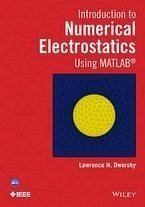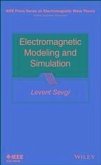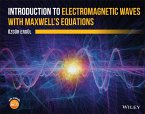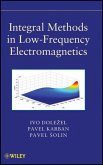Introduction to Numerical Electrostatics Using MATLAB (eBook, PDF)


Alle Infos zum eBook verschenken

Introduction to Numerical Electrostatics Using MATLAB (eBook, PDF)
- Format: PDF
- Merkliste
- Auf die Merkliste
- Bewerten Bewerten
- Teilen
- Produkt teilen
- Produkterinnerung
- Produkterinnerung

Hier können Sie sich einloggen

Bitte loggen Sie sich zunächst in Ihr Kundenkonto ein oder registrieren Sie sich bei bücher.de, um das eBook-Abo tolino select nutzen zu können.
Readers are guided step by step through numerous specific problems and challenges, covering all aspects of electrostatics with an emphasis on numerical procedures. The author focuses on practical examples, derives mathematical equations, and addresses common issues with algorithms. Introduction to Numerical Electrostatics contains problem sets, an accompanying web site with simulations, and a complete list of computer codes. * Computer source code listings on accompanying web site * Problem sets included with book * Readers using MATLAB or other simulation packages will gain insight as to the…mehr
- Geräte: PC
- mit Kopierschutz
- eBook Hilfe
- Größe: 13.47MB
![Electromagnetic Modeling and Simulation (eBook, PDF) Electromagnetic Modeling and Simulation (eBook, PDF)]() Levent SevgiElectromagnetic Modeling and Simulation (eBook, PDF)126,99 €
Levent SevgiElectromagnetic Modeling and Simulation (eBook, PDF)126,99 €![Parallel Solution of Integral Equation-Based EM Problems in the Frequency Domain (eBook, PDF) Parallel Solution of Integral Equation-Based EM Problems in the Frequency Domain (eBook, PDF)]() Yu ZhangParallel Solution of Integral Equation-Based EM Problems in the Frequency Domain (eBook, PDF)112,99 €
Yu ZhangParallel Solution of Integral Equation-Based EM Problems in the Frequency Domain (eBook, PDF)112,99 €![Introduction to Electromagnetic Waves with Maxwell's Equations (eBook, PDF) Introduction to Electromagnetic Waves with Maxwell's Equations (eBook, PDF)]() Ozgur ErgulIntroduction to Electromagnetic Waves with Maxwell's Equations (eBook, PDF)127,99 €
Ozgur ErgulIntroduction to Electromagnetic Waves with Maxwell's Equations (eBook, PDF)127,99 €![Integral Methods in Low-Frequency Electromagnetics (eBook, PDF) Integral Methods in Low-Frequency Electromagnetics (eBook, PDF)]() Pavel SolinIntegral Methods in Low-Frequency Electromagnetics (eBook, PDF)117,99 €
Pavel SolinIntegral Methods in Low-Frequency Electromagnetics (eBook, PDF)117,99 €![Forward and Inverse Scattering Algorithms Based on Contrast Source Integral Equations (eBook, PDF) Forward and Inverse Scattering Algorithms Based on Contrast Source Integral Equations (eBook, PDF)]() Peter M. van den BergForward and Inverse Scattering Algorithms Based on Contrast Source Integral Equations (eBook, PDF)130,99 €
Peter M. van den BergForward and Inverse Scattering Algorithms Based on Contrast Source Integral Equations (eBook, PDF)130,99 €![Practical Design of Magnetostatic Structure Using Numerical Simulation (eBook, PDF) Practical Design of Magnetostatic Structure Using Numerical Simulation (eBook, PDF)]() Qiuliang WangPractical Design of Magnetostatic Structure Using Numerical Simulation (eBook, PDF)111,99 €
Qiuliang WangPractical Design of Magnetostatic Structure Using Numerical Simulation (eBook, PDF)111,99 €![Numerical Analysis in Electromagnetics (eBook, PDF) Numerical Analysis in Electromagnetics (eBook, PDF)]() Pierre SaguetNumerical Analysis in Electromagnetics (eBook, PDF)139,99 €
Pierre SaguetNumerical Analysis in Electromagnetics (eBook, PDF)139,99 €-
-
-
Dieser Download kann aus rechtlichen Gründen nur mit Rechnungsadresse in A, B, BG, CY, CZ, D, DK, EW, E, FIN, F, GR, HR, H, IRL, I, LT, L, LR, M, NL, PL, P, R, S, SLO, SK ausgeliefert werden.
Hinweis: Dieser Artikel kann nur an eine deutsche Lieferadresse ausgeliefert werden.
- Produktdetails
- Verlag: John Wiley & Sons
- Seitenzahl: 464
- Erscheinungstermin: 18. Februar 2014
- Englisch
- ISBN-13: 9781118755716
- Artikelnr.: 40515074
- Verlag: John Wiley & Sons
- Seitenzahl: 464
- Erscheinungstermin: 18. Februar 2014
- Englisch
- ISBN-13: 9781118755716
- Artikelnr.: 40515074
- Herstellerkennzeichnung Die Herstellerinformationen sind derzeit nicht verfügbar.
Introduction xiii
Acknowledgments xv
1 A Review of Basic Electrostatics 1
1.1 Charge, Force, and the Electric Field 1
1.2 Electric Flux Density and Gauss's Law 5
1.3 Conductors 7
1.4 Potential, Gradient, and Capacitance 10
1.5 Energy in the Electric Field 16
1.6 Poisson's and Laplace's Equations 18
1.7 Dielectric Interfaces 20
1.8 Electric Dipoles 24
1.9 The Case for Approximate Numerical Analysis 27
Problems 29
2 The Uses of Electrostatics 33
2.1 Basic Circuit Theory 33
2.2 Radio Frequency Transmission Lines 41
2.3 Vacuum Tubes and Cathode Ray Tubes 44
2.4 Field Emission and the Scanning Electron Microscope 47
2.5 Electrostatic Force Devices 48
2.6 Gas Discharges and Lighting Devices 49
3 Introduction to the Method of Moments Technique for Electrostatics 51
3.1 Fundamental Equations 51
3.2 A Working Equation Set 55
3.3 The Single-Point Approximation for Off-Diagonal Terms 56
3.4 Exact Solutions for the Diagonal Term and In-Plane Terms 57
3.5 Approximating Li,j 61
Problems 64
4 Examples using the Method of Moments 67
4.1 A First Modeling Program 67
4.2 Input Data File Preparation for the First Modeling Program 68
4.3 Processing the Input Data 71
4.4 Generating the Li,j Array 73
4.5 Solving the System and Examining Some Results 73
4.6 Limits of Resolution 76
4.7 Voltages and Fields 78
4.8 Varying the Geometry 82
Problems 87
5 Symmetries, Images and Dielectrics 89
5.1 Symmetries 89
5.2 Images 90
5.3 Multiple Images and the Symmetric Stripline 95
5.4 Dielectric Interfaces 102
5.5 Two-Dimensional Cross Sections of Uniform Three-Dimensional Structures
108
5.6 Charge Profiles and Current Bunching 113
5.7 Cylinder between Two Planes 116
Problems 121
6 Triangles 123
6.1 Introduction to Triangular Cells 123
6.2 Right Triangles 124
6.3 Calculating Li,i (Self ) Coefficients 125
6.4 Calculating Li,j for i ¿ j 127
6.5 Basic Meshing and Data Formats for Triangular Cell MoM Programs 127
6.6 Using MATLAB to Generate Triangular Meshings 135
6.7 Calculating Voltages 139
6.8 Calculating the Electric Field 141
6.9 Three-Dimensional Structures 143
6.10 Charge Profiles 152
Problems 156
7 Summary and Overview 159
7.1 Where We Were, Where We're Going 159
8 The Finite Difference Method 163
8.1 Introduction and a Simple Example 163
8.2 Setting Up and Solving a Basic Problem 165
8.3 The Gauss-Seidel (Relaxation) Solution Technique 172
8.4 Charge, Gauss's Law, and Resolution 175
8.5 Voltages and Fields 177
8.6 Stored Energy and Capacitance 178
Problems 181
9 Refining the Finite Difference Method 183
9.1 Refined Grids 183
9.2 Arbitrary Conductor Shapes 189
9.3 Mixed Dielectric Regions and a New Derivation of the Finite Difference
Equation 194
9.4 Example: Structure with a Dielectric Interface 195
9.5 Axisymmetric Cylindrical Coordinates 196
9.6 Symmetry Boundary Condition 205
9.7 Duality, and Upper and Lower Bounds to Solutions for Transmission Lines
207
9.8 Extrapolation 214
9.9 Three-Dimensional Grids 217
Problems 223
10 Multielectrode Systems 227
10.1 Multielectrode Structures 227
10.2 Utilizing Superposition 229
10.3 Utilizing Symmetry 230
10.4 Circuital Relations and a Caveat 230
10.5 Floating Electrodes 232
Problems 234
11 Probabilistic Potential Theory 237
11.1 Random Walks and the Diffusion Equation 237
11.2 Voltage at a Point from Random Walks 239
11.3 Diffusion 246
11.4 Variable-Step-Size Random Walks 249
11.5 Three-Dimensional Structures 260
Problems 261
12 The Finite Element Method (FEM) 265
12.1 Introduction 265
12.2 Solving Laplace's Equation by Minimizing Stored Energy 266
12.3 A Simple One-Dimensional Example 267
12.4 A Very Simple Finite Element Approximation 271
12.5 Arbitrary Number of Lines Approximation 274
12.6 Mixed Dielectrics 278
12.7 A Quadratic Approximation 279
12.8 A Simple Two-Dimensional FEM Program 282
Problems 287
13 Triangles and Two-Dimensional Unstructured Grids 289
13.1 Introduction 289
13.2 Aside: The Area of a Triangle 290
13.3 The Coefficient Matrix 291
13.4 A Simple Example 293
13.5 A Two-Dimensional Triangular Mesh Program 296
Problems 300
14 A Zoning System and Some Examples 303
14.1 General Introduction 303
14.2 Introduction to gmsh 304
14.3 Translating the gmsh.msh File 308
14.4 Running the FEM Analysis 319
14.5 More gmsh Features and Examining the Electric Field 320
14.6 Multiple Electrodes 324
Problems 327
15 Some FEM Topics 329
15.1 Symmetries 329
15.2 A Symmetry Example, Including a Two-Sided Capacitance Estimate 330
15.3 Axisymmetric Structures 337
15.4 The Graded-Potential Boundary Condition 348
15.5 Unbounded Regions 352
15.6 Dielectric Materials 364
Problems 371
16 FEM in Three Dimensions 375
16.1 Creating Three-Dimensional Meshes 375
16.2 The FEM Coefficient Matrix in Three Dimensions 384
16.3 Parsing the gmsh Files and Setting Boundary Conditions 386
16.4 Open Boundaries and Cylinders in Space 392
Problems 396
17 Electrostatic Forces 399
17.1 Introduction 399
17.2 Electron Beam Acceleration and Control 400
17.3 The Electrostatic Relay (Switch) 408
17.4 Electrets and Piezoelectricity: An Overview 414
17.5 Points on a Sphere 415
Problems 419
Appendix Interfacing with Other Languages 423
Index 431
Introduction xiii
Acknowledgments xv
1 A Review of Basic Electrostatics 1
1.1 Charge, Force, and the Electric Field 1
1.2 Electric Flux Density and Gauss's Law 5
1.3 Conductors 7
1.4 Potential, Gradient, and Capacitance 10
1.5 Energy in the Electric Field 16
1.6 Poisson's and Laplace's Equations 18
1.7 Dielectric Interfaces 20
1.8 Electric Dipoles 24
1.9 The Case for Approximate Numerical Analysis 27
Problems 29
2 The Uses of Electrostatics 33
2.1 Basic Circuit Theory 33
2.2 Radio Frequency Transmission Lines 41
2.3 Vacuum Tubes and Cathode Ray Tubes 44
2.4 Field Emission and the Scanning Electron Microscope 47
2.5 Electrostatic Force Devices 48
2.6 Gas Discharges and Lighting Devices 49
3 Introduction to the Method of Moments Technique for Electrostatics 51
3.1 Fundamental Equations 51
3.2 A Working Equation Set 55
3.3 The Single-Point Approximation for Off-Diagonal Terms 56
3.4 Exact Solutions for the Diagonal Term and In-Plane Terms 57
3.5 Approximating Li,j 61
Problems 64
4 Examples using the Method of Moments 67
4.1 A First Modeling Program 67
4.2 Input Data File Preparation for the First Modeling Program 68
4.3 Processing the Input Data 71
4.4 Generating the Li,j Array 73
4.5 Solving the System and Examining Some Results 73
4.6 Limits of Resolution 76
4.7 Voltages and Fields 78
4.8 Varying the Geometry 82
Problems 87
5 Symmetries, Images and Dielectrics 89
5.1 Symmetries 89
5.2 Images 90
5.3 Multiple Images and the Symmetric Stripline 95
5.4 Dielectric Interfaces 102
5.5 Two-Dimensional Cross Sections of Uniform Three-Dimensional Structures
108
5.6 Charge Profiles and Current Bunching 113
5.7 Cylinder between Two Planes 116
Problems 121
6 Triangles 123
6.1 Introduction to Triangular Cells 123
6.2 Right Triangles 124
6.3 Calculating Li,i (Self ) Coefficients 125
6.4 Calculating Li,j for i ¿ j 127
6.5 Basic Meshing and Data Formats for Triangular Cell MoM Programs 127
6.6 Using MATLAB to Generate Triangular Meshings 135
6.7 Calculating Voltages 139
6.8 Calculating the Electric Field 141
6.9 Three-Dimensional Structures 143
6.10 Charge Profiles 152
Problems 156
7 Summary and Overview 159
7.1 Where We Were, Where We're Going 159
8 The Finite Difference Method 163
8.1 Introduction and a Simple Example 163
8.2 Setting Up and Solving a Basic Problem 165
8.3 The Gauss-Seidel (Relaxation) Solution Technique 172
8.4 Charge, Gauss's Law, and Resolution 175
8.5 Voltages and Fields 177
8.6 Stored Energy and Capacitance 178
Problems 181
9 Refining the Finite Difference Method 183
9.1 Refined Grids 183
9.2 Arbitrary Conductor Shapes 189
9.3 Mixed Dielectric Regions and a New Derivation of the Finite Difference
Equation 194
9.4 Example: Structure with a Dielectric Interface 195
9.5 Axisymmetric Cylindrical Coordinates 196
9.6 Symmetry Boundary Condition 205
9.7 Duality, and Upper and Lower Bounds to Solutions for Transmission Lines
207
9.8 Extrapolation 214
9.9 Three-Dimensional Grids 217
Problems 223
10 Multielectrode Systems 227
10.1 Multielectrode Structures 227
10.2 Utilizing Superposition 229
10.3 Utilizing Symmetry 230
10.4 Circuital Relations and a Caveat 230
10.5 Floating Electrodes 232
Problems 234
11 Probabilistic Potential Theory 237
11.1 Random Walks and the Diffusion Equation 237
11.2 Voltage at a Point from Random Walks 239
11.3 Diffusion 246
11.4 Variable-Step-Size Random Walks 249
11.5 Three-Dimensional Structures 260
Problems 261
12 The Finite Element Method (FEM) 265
12.1 Introduction 265
12.2 Solving Laplace's Equation by Minimizing Stored Energy 266
12.3 A Simple One-Dimensional Example 267
12.4 A Very Simple Finite Element Approximation 271
12.5 Arbitrary Number of Lines Approximation 274
12.6 Mixed Dielectrics 278
12.7 A Quadratic Approximation 279
12.8 A Simple Two-Dimensional FEM Program 282
Problems 287
13 Triangles and Two-Dimensional Unstructured Grids 289
13.1 Introduction 289
13.2 Aside: The Area of a Triangle 290
13.3 The Coefficient Matrix 291
13.4 A Simple Example 293
13.5 A Two-Dimensional Triangular Mesh Program 296
Problems 300
14 A Zoning System and Some Examples 303
14.1 General Introduction 303
14.2 Introduction to gmsh 304
14.3 Translating the gmsh.msh File 308
14.4 Running the FEM Analysis 319
14.5 More gmsh Features and Examining the Electric Field 320
14.6 Multiple Electrodes 324
Problems 327
15 Some FEM Topics 329
15.1 Symmetries 329
15.2 A Symmetry Example, Including a Two-Sided Capacitance Estimate 330
15.3 Axisymmetric Structures 337
15.4 The Graded-Potential Boundary Condition 348
15.5 Unbounded Regions 352
15.6 Dielectric Materials 364
Problems 371
16 FEM in Three Dimensions 375
16.1 Creating Three-Dimensional Meshes 375
16.2 The FEM Coefficient Matrix in Three Dimensions 384
16.3 Parsing the gmsh Files and Setting Boundary Conditions 386
16.4 Open Boundaries and Cylinders in Space 392
Problems 396
17 Electrostatic Forces 399
17.1 Introduction 399
17.2 Electron Beam Acceleration and Control 400
17.3 The Electrostatic Relay (Switch) 408
17.4 Electrets and Piezoelectricity: An Overview 414
17.5 Points on a Sphere 415
Problems 419
Appendix Interfacing with Other Languages 423
Index 431







